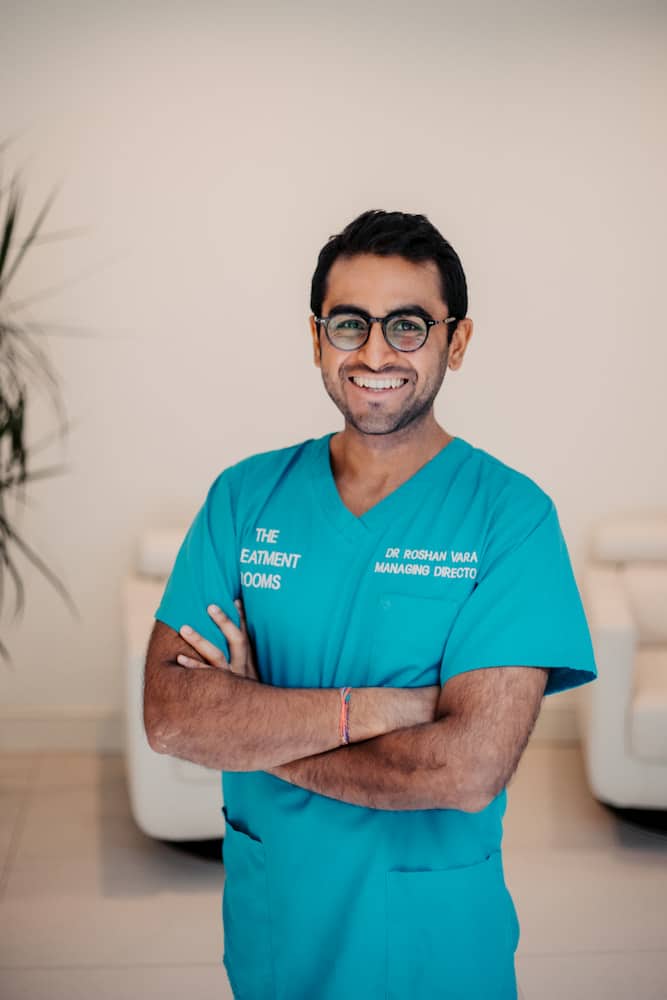It takes approximately 10-14 days for newly implanted grafts to become secure after a hair transplant. You must be extra careful not to hit or damage these newly implanted grafts in the first 10-14 days. This is important to know as it affects your hair transplant aftercare and recovery, your return to work, and your lifestyle.
In this article, we are going to explain how and why it takes 10-14 days for your newly implanted grafts to become secure and how this affects your aftercare.
What is a hair transplant?
An FUE hair transplant involves relocating hairs from one part of the scalp or body (donor area) to a new area (recipient area). This typically involves taking hairs from the back and sides of the scalp and placing them into the crown (also known as a crown hair transplant), mid-scalp, or frontal hairline to treat areas of balding.
The hairs that are relocated should grow for life. Hair transplantation is therefore seen as a permanent solution to balding.
Whether hair loss has genetic or hormonal causes (male pattern baldness) or is due to a condition, a hair transplant can restore your head of hair, giving you a more youthful appearance and improving self-esteem.
Hair transplants are undertaken by a dermatological or hair transplant surgeon and are performed under local anaesthesia. There are two main methods of hair transplant which you are likely to come across; these are:
- Follicular unit transplantation (FUT)
- Follicular unit excision (FUE)
FUT takes a section of the scalp from the back of the head, closes the incision site, then separates the strip into small sections before implanting them into the bald area.
Whereas, in an FUE procedure, the surgeon carefully extracts hair follicles directly from the back of the head with a number of small punch incisions, before implanting them in tiny holes in the balding area. FUE hair transplants can be a preferred method of treatment as they are less invasive and the recovery is a lot less painful and time-consuming.

What are hair grafts?
You might be unclear as to what exactly hair grafts are, so first, let’s be sure of their definition. Hair grafts are used in surgical hair transplantation, which harvests healthy hair follicles and transfers them to balding areas of the head.
A hair graft is a piece of skin that contains healthy hair follicles and is removed to be transplanted elsewhere on the scalp. While hair grafts can theoretically be taken from anywhere on your body, they are usually taken from the back of the head, also known as the posterior scalp.
Typically one graft sprouts 2-3 hairs. If you look at the hair on your scalp, arm, or body you will often see groups of hairs coming out of one graft in the skin. The size of a hair graft extracted will depend on the surgical technique being used, and the tools and technology it involves.
To learn more about what hair grafts are, visit our How Many Hair Grafts Do I Need For My FUE Hair Transplant? for more information.
What happens with hair grafts during hair transplant surgery?
Hair grafts are taken as individual follicles from the back of the head with hundreds, or even thousands, of small punch incisions. They are then placed in a solution to keep them hydrated and cool.
Once enough hair grafts have been extracted, they are relocated into an area of balding. This can be the front of the scalp, mid-scalp, or crown.
The grafts are placed into small <1mm holes in the scalp to recreate hair where there were none previously. After all the grafts have been transplanted the back of the scalp or donor area is bandaged.
How long does it take for the grafts to become secure?
There are several factors that can affect the survival of hair grafts – such as dehydration, lack of oxygen, and temperature. For this reason, you must follow your surgeon’s instructions on how to look after your newly implanted grafts.
Like repotting a plant, each new graft is quite fragile in its new location. It can take a while for the graft to fully “root-in”. This is typically 14 days and it involves the scalp healing itself after surgery and securing each graft in its new location.
You might be advised to avoid exercise after a hair transplant in order to reduce redness and stop sweat from contaminating the fragile areas, at least for 2 weeks and potentially for 1 month. A bandage will be applied to the donor area for 24 hours. The donor area, unlike the recipient area will heal quickly after surgery.
By day 5, the hair grafts should be secure enough for you to wash your hair gently without touching it by hand.
Tips to care for hair grafts after a hair transplant
As we touched upon earlier, caring for your hair grafts in the days and weeks following a hair transplant is key to their survival. So here are a few things you should, and shouldn’t, do:
Do’s
- Do wash your hair daily from 4 days after the procedure, to help with healing and remove scabs
- Do keep your grafts moist especially in the first 4 days after surgery by spraying them with a saltwater solution
- Do use over the counter pain medication to ease discomfort and help you to sleep in the days following the procedure
- Do wear a hat outside for around two weeks following the procedure, to protect your hair grafts from environmental factors
Don’ts
- Don’t rub your hair with a towel made from fabric. Instead, let it air dry
- Don’t scratch or rub your scalp
- Don’t wear beanie hats
- Don’t touch your implanted grafts heavily when showering or grooming yourself
- Don’t do any intense physical activity within the first 14 days after a hair transplant, as all the hair follicles might not yet be healed
- Don’t have any other kind of manipulative surgery or treatment on the scalp for at least three months following your hair transplant
- Don’t expose your hair to strong, high UV sunlight after a hair transplant for at least 2 weeks
After 2 weeks have passed your grafts should be secure in your scalp. Contact sport is the only exercise you will need to wait a little longer for. If you are a rugby or football player you should avoid playing these sports or play a non-contact form for 4 weeks.
How long does it take to heal?
It must be remembered that there are a number of factors that can influence recovery time. It’s also important to remember to follow the aftercare and recovery instructions given to you by your surgeon to get the best and quickest results.
Let’s look at the recovery times for the two parts of the head involved in a hair transplant – the scalp (recipient area) and the donor area.
Scalp
Due to the nature of an FUE hair transplant procedure, recovery of the scalp is typically faster than a FUT procedure, with the recipient area usually healed within 5 to 14 days. During this time you are strongly encouraged to follow the surgeon’s advice on the best way to keep your scalp clean and free from dirt and bacteria.
Donor area
During an FUE procedure, the surgeon will delicately make tiny incisions around each follicle and extract them individually. Because the incisions are minuscule, the donor area recovery time only takes five to seven days.
For more information about the recovery process, please visit our aftercare and recovery page.
How long will it take for my grafts to grow?
It will take approximately 8-12 months for your hair to grow after a transplant. Initially, you will see some of your hair shed in the first 2-3 months. After this initial shedding phase your roots will begin to grow your new hair.
To get a better understanding of the results of hair transplant surgery, visit our FUE hair transplant before and after page for more information.
How The Treatment Rooms London can help you
If you’re considering getting an FUE hair transplant and are in need of more information, please book a consultation with one of our expert surgeons. They will be able to advise you on the best possible options and inform you about the latest treatments available, as well as answer any questions you may have. Getting a hair transplant has never been easier, just contact a member of our team today.
Share:
Authored by
Reviewed by
Book a Consultation
Related Blogs
When Can You Safely Wear a Beanie After a Hair Transplant?
July 3, 2025
Quick Summary Cap Recommendations: Light, breathable caps, such as snapbacks or trucker hats, are advisable if you need…
Castor Oil (Ricino Oil) for Hair Growth: Benefits, Uses & How to Apply for Maximum Results
June 26, 2025
Castor oil, also known as Ricino oil, is extracted from the Castor bean plant (Ricinus communis). During…
What is a Hair Transplant? How it Works, Success Rate & What to Expect
June 23, 2025
Hair transplantation is a cosmetic surgical procedure that restores hair by moving healthy follicles from one part…
John Cena Hair Transplant
May 14, 2025
John Cena, a common household name, is a figure who has effortlessly straddled the worlds of professional…
Kyle Walker Hair Transplant: Before, After, and His New Hairline
May 12, 2025
Kyle Walker is known for his defensive skills at Tottenham Hotspur, Manchester City, and in the England…
Celebrity Hair Transplants: Full Before and After Analysis
May 8, 2025
Elon Musk Hair Transplant Elon Musk, the billionaire behind Tesla and SpaceX, is well-known for his innovations…
Lewis Hamilton Hair Transplant: Before, After, and His New Hairline
May 7, 2025
As a top-class racing driver, Hamilton is used to wearing a race helmet. While this does protect…
James Nesbitt Hair Transplant: Before, After, and His New Hairline
May 6, 2025
James Nesbitt, the Northern Irish actor famed for his role as Adam Williams in the British comedy-drama…
How Many Hair Grafts Do You Need For A FUE Hair Transplant?
May 3, 2025
An Follicular Unit Excision (FUE) or FUT hair transplant are 2 main procedures available to address hair…











